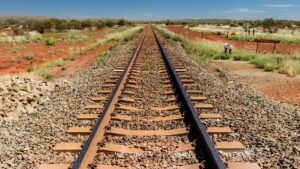Super profits may be gone for now, but Rio Tinto sees energy transition powering commodity demand for years to come

Pic: WestEnd61/WestEnd61 via Getty Images
Rio Tinto (ASX:RIO) has seen profits fall 41% in 2022, with lower iron ore prices forcing it to cut its full year dividend by 38% to US$4.92 per share.
The 60% payout, including a US$2.25 final dividend, was described by CEO Jakob Stausholm as the miner’s second biggest dividend ever after paying out US$7.93/sh in 2021, when it reported the biggest profit in the Anglo-Australian miner’s 150-year history.
For the full year Rio will pay out around $11.7b (Aussie) to shareholders, around $5.7b in the final divvie.
It means the big three of BHP (ASX:BHP), Fortescue (ASX:FMG) and Rio will return an aggregate of $15.6b to shareholders over the next month, down on last year’s total of more than $20b.
The combined decline in profits across the iron ore majors came off weaker iron ore prices through the second half of 2022, a situation that has turned around early this year, with prices of US$131/t around 60% up on lows seen in October last year of ~US$80/t.
Speaking to media after the release of the results, Rio Tinto CEO Jakob Stausholm did not accept that a “supercycle” was over, saying the energy transition would power long term demand for commodities.
He attributed the mad run up in prices seen between 2019 and 2021 to supply and demand side issues, heavily impacted by the Covid-19 pandemic.
“It has been quite extraordinary period, but the extraordinary period has more been kind of … unanticipated disruptions. Now, I have been almost five years, four and a half years in Rio Tinto and there’s actually been disruptions to the market all along,” he said.
“But it’s more been often on the supply side. Then, of course, there’s been something on the demand side on COVID. But actually, I’m not sure that what you’re really seeing is a supercycle here, what you see is a normal good demand from urbanisation globally.
“And then of course, we get this extra kicker which are bound to go on for decades, from the energy transition. Building a whole new energy system requires a lot more of the materials we are providing.
“So that’s why we are saying we by and large face markets that in aggregate, on a weighted average, would grow 3.7% per year, from now until the mid-30s.
“So the demand will be there, what the pricing environment will be, that’s probably anybody’s guess. But I will agree with it has been good years and it looks like at least we’re entering well into 2023.”
Rio has played into that narrative not just with its traditional iron ore, copper and aluminium divisions, but also by becoming the first major to step significantly into lithium, where it sees demand rising as much as sevenfold by 2030.
A 3000tpa starter plant at the Rincon brine in Argentina could see Rio enter that market from 2024.
Inflation hit adds to earnings cut
Lower commodity prices represented a US$8.1b hit to Rio’s earnings, which fell from US$37.72 billion in 2021 to US$26.27b, US$9.15b of that due to iron ore and US$733m in copper and provisional price impacts.
Inflationary pressures were evident as well, with general inflation carving US$1.478b out of its earnings, energy accounting for US$1.169b and cash costs behind US$2.202b in the earnings slide.
Rio produced 322Mt of iron ore in 2022 at unit costs of US$21.30/t, slightly above its US$19.50-21/t guidance, with copper output of 521,000t mined and 209,000t refined at C1 costs of US163c/lb.
It expects to produce 320-335Mt of iron ore at US$21-22.5/t in 2023, with mined copper production of 650-710,000t at US160-180c/lb and refined copper of 180-210,000t.
While the results were down, the combined full year and half year dividend was slightly above analyst consensus.
“Today’s result was in line with expectations, with higher cost inflation in aluminium driving a very small miss,” RBC’s Tyler Broda said.
“After recent volatility in RIO’s iron ore division, the in-line performance will likely be viewed positively, especially in the context of the strong production numbers in Q4.
“Although net debt at $4.2bn came in higher than cons and RBC at $2.7bn, other than currency derivatives losses, the differences appear to be timing. Importantly this didn’t impact the final dividend at 225 cents, ahead of RBC 222 and cons at 223.”
Stausholm reiterated his aversion to large scale “transformational” M & A like that being pursued by major rival BHP in its $9.6 billion OZ Minerals (ASX:OZL) deal.
Broda said RBC views Rio as a sector perform, with M & A less of a concern than other miners amid its view iron ore prices will fall.
“We continue to expect the sector as a whole to derate through 2023 and iron ore to be weak into underwhelming Chinese steel demand which is likely to hamper the shares from current levels,” he said.
“Similar to the rest of the industry, compressing margins and rising capex will place pressure on free cash flow generation.
“However risks around M&A are potentially lower at Rio Tinto, and the near-term growth is amongst the highest in the sector in our view which could allow its relative performance to continue to improve after three challenging years.”
Unit cost not the be all end all
Stausholm provided limited updates on projects like Simandou and Rincon, with work still ongoing to complete the infrastructure JV deal to develop the giant African orebody, which the Rio CEO said could be the biggest mining project in the world.
In Australia, he said Rio was pleased to have gotten production back on track at its Pilbara iron ore operations, prioritising its execution and product mix over controlling costs.
“There are inflationary pressures, but I tend to just focus on what we can control and that is … you’re much higher rewarded for being more efficient during tight times like now,” he said.
“So I’m quite confident that we are able to manoeuvre that.
“But so far the unit cost has not been the first priority, we’ve got production back on track and as you’ve probably seen here today, at the moment, we have high iron ore prices, we have also by stabilising the production got a better quality, and therefore a better price against the benchmark.
“And those are from an economic perspective, by far the most important, we want to be super efficient on unit cost but I’m not going to cut maintenance and things like that for the sake of achieving a unit cost target.”
Rio Tinto (ASX:RIO) share price today:
Related Topics

UNLOCK INSIGHTS
Discover the untold stories of emerging ASX stocks.
Daily news and expert analysis, it's free to subscribe.
By proceeding, you confirm you understand that we handle personal information in accordance with our Privacy Policy.








